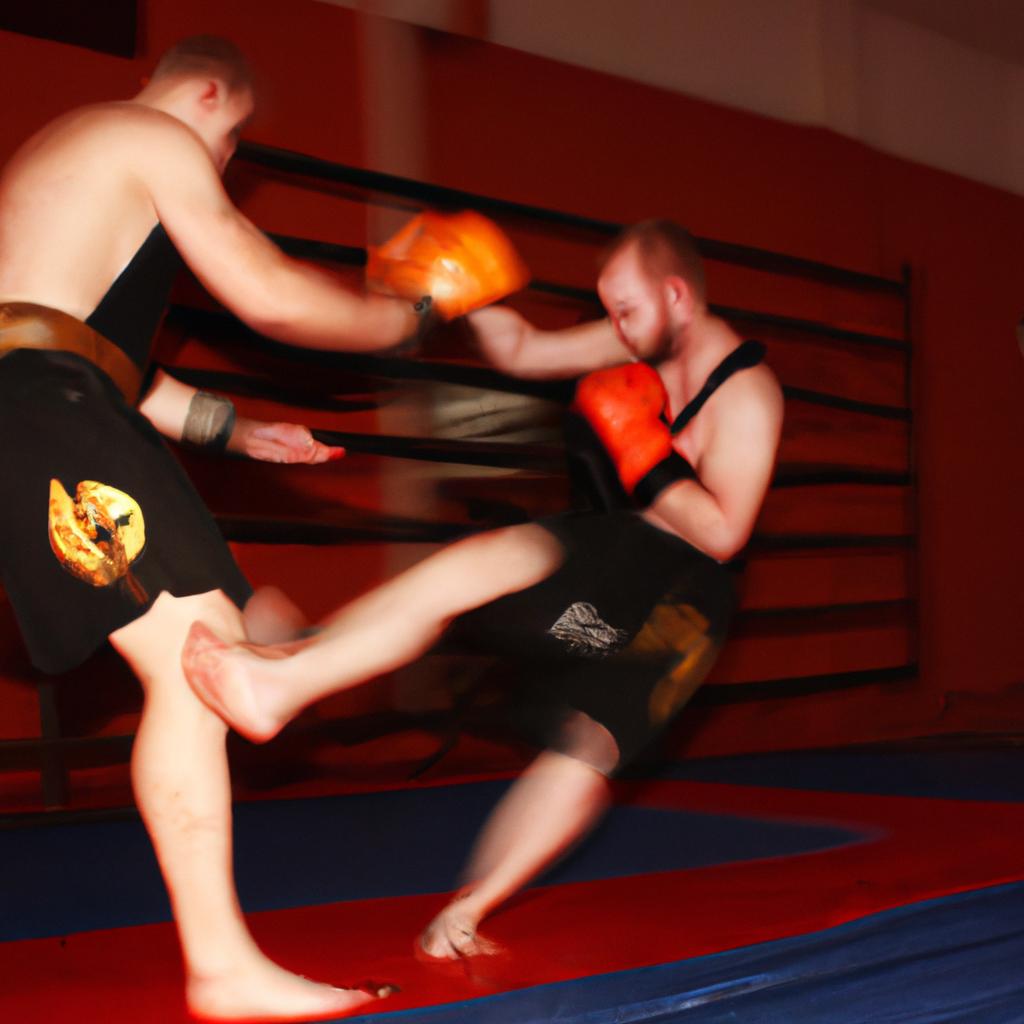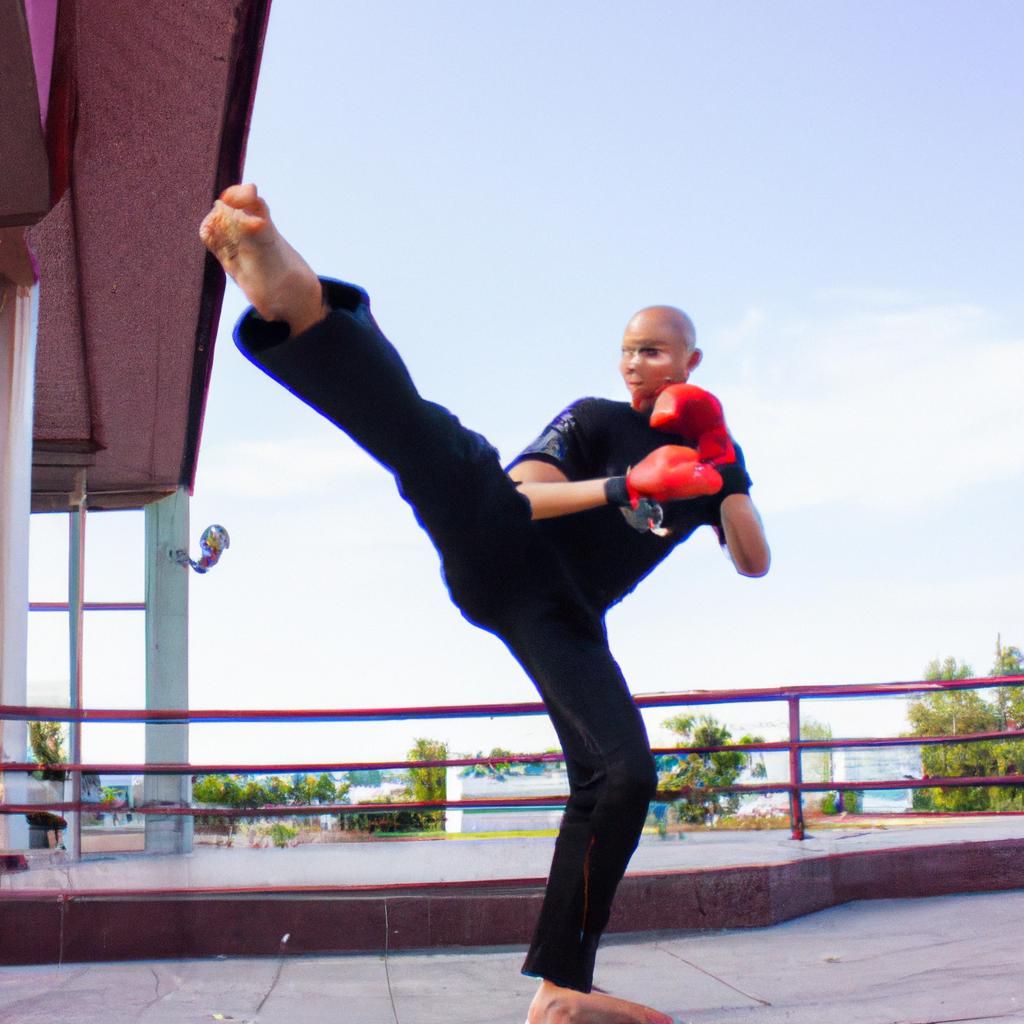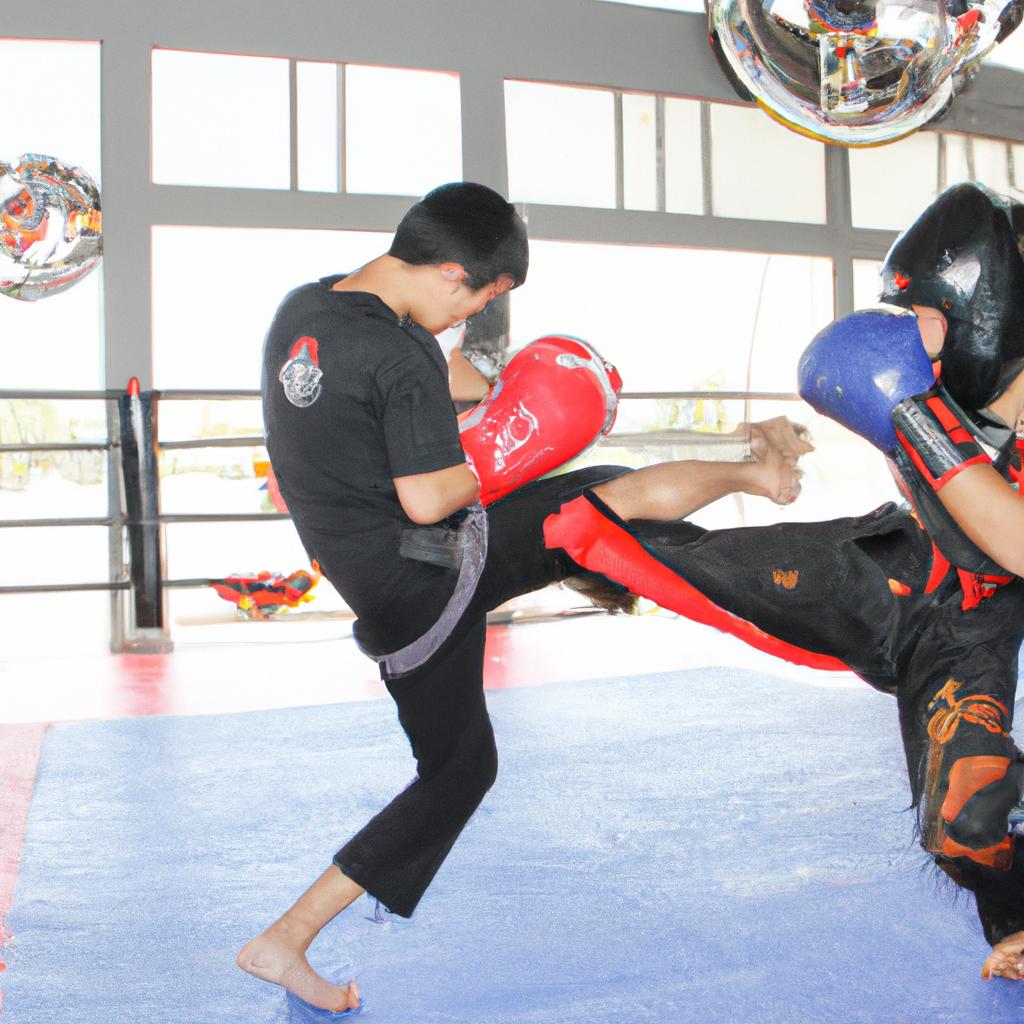MMA, or Mixed Martial Arts, is a combat sport that combines various techniques and disciplines from different martial arts. Among these disciplines, Muay Thai stands out as one of the most effective striking forms in MMA. However, mastering Muay Thai for MMA requires more than just learning its basic techniques; it demands a deep understanding of specific strategies and tactics that can be employed inside the octagon. For instance, imagine a hypothetical case where an experienced MMA fighter with a background in Brazilian Jiu-Jitsu faces off against an equally skilled opponent proficient in Muay Thai. Despite possessing excellent ground skills, the BJJ practitioner finds themselves struggling to maintain control due to their inability to handle the relentless attacks by their Muay Thai counterpart. This scenario highlights the critical importance of unlocking mastery in Muay Thai within the context of MMA.
To unlock such mastery in Muay Thai for MMA, fighters must first develop a solid foundation in the art’s fundamental techniques. The basic strikes used in this discipline include punches, kicks, elbows, and knees – all executed with precision and power. Understanding how to generate maximum force while maintaining balance and proper technique becomes crucial when engaging opponents who are well-versed in various grappling styles. Additionally, footwork plays a vital role in ev ading takedowns and creating angles for effective striking.
Once the fundamental techniques are mastered, fighters need to learn how to adapt them specifically for MMA. In Muay Thai competitions, fighters are allowed to clinch and strike with their knees and elbows, but in MMA, there are additional considerations such as defending against takedowns and submissions. Therefore, fighters must learn how to seamlessly transition from striking to grappling and vice versa.
Furthermore, understanding distance management is essential in Muay Thai for MMA. Fighters must know when to stay on the outside and utilize long-range strikes like kicks and jabs, or when to close the distance and engage in close-quarters combat using clinches and short-range strikes. This ability to control the range effectively can dictate the outcome of a fight.
Strategies for countering specific grappling techniques also play a significant role in mastering Muay Thai for MMA. For example, learning how to defend against takedowns by utilizing well-timed knee strikes or sprawls can prevent opponents from taking the fight to the ground where they may have an advantage.
In summary, unlocking mastery in Muay Thai for MMA requires more than just learning the basic techniques of this striking art. It involves developing a deep understanding of strategies and tactics that cater specifically to the demands of mixed martial arts. By combining solid fundamentals with adaptation for MMA ruleset, distance management skills, and effective counter-grappling techniques, fighters can unlock the full potential of Muay Thai within an MMA context.
Understanding the Importance of Range and Distance in MMA
One crucial aspect that plays a significant role in the mastery of Muay Thai within the realm of Mixed Martial Arts (MMA) is understanding the importance of range and distance. By effectively utilizing these concepts, fighters can gain a strategic advantage over their opponents. For instance, imagine a hypothetical scenario where two fighters are engaged in an intense match. Fighter A excels at close-quarters combat while Fighter B possesses exceptional long-range striking abilities. In this case, Fighter A would need to find ways to close the distance without getting hit by Fighter B’s strikes.
To emphasize the significance of mastering range and distance in MMA, consider the following bullet points:
- Proper management of range allows fighters to control engagements and dictate the pace of the fight.
- Understanding optimal striking distances enables effective utilization of techniques such as jabs, hooks, uppercuts, and kicks.
- Maintaining appropriate distancing helps avoid being susceptible to counterattacks from opponents with longer reach or superior footwork.
- Skilled manipulation of range facilitates takedowns and grappling maneuvers when transitioning between different phases of a fight.
Furthermore, visual aids like tables can enhance our comprehension. The table below illustrates various ranges commonly encountered in MMA bouts:
| Range | Description | Examples |
|---|---|---|
| Long Range | Fighters are positioned far apart | Jab, Teep kick |
| Mid Range | Close enough for punches but too far for clinching | Cross punch, Roundhouse kick |
| Short Range | Grappling distance | Elbow strike, Knee strike |
By grasping these essential aspects related to range and distance management, fighters can strategically exploit their strengths while mitigating vulnerabilities against opponents who excel in specific areas. Ultimately, it is through this understanding that one can develop a comprehensive approach to Muay Thai in MMA.
Transitioning into the subsequent section about “Developing Strong Striking Techniques for MMA,” it is crucial to build upon the foundation of range and distance understanding. By incorporating effective striking techniques, fighters can optimize their offensive capabilities while maintaining control over engagements in the ring or cage.
Developing Strong Striking Techniques for MMA
Section H2: ‘Developing Strong Striking Techniques for MMA’
Having gained an understanding of the importance of range and distance in MMA, it is now crucial to focus on developing strong striking techniques. By mastering these techniques, fighters can effectively utilize their striking skills to dominate their opponents inside the cage. To illustrate this point, consider a hypothetical scenario where an MMA fighter with impeccable striking technique utilizes his skills to maintain control over the fight and secure a knockout victory.
Strategies for Developing Strong Striking Techniques:
To develop formidable striking techniques for MMA, fighters must incorporate a combination of training methodologies and strategic approaches into their practice routines. Here are some key strategies that can help enhance one’s striking abilities:
- Technical Precision: Focus on perfecting fundamental strikes such as jabs, crosses, hooks, and uppercuts by practicing them repetitively with precision and accuracy.
- Footwork and Angles: Master footwork techniques like pivoting, shuffling, and lateral movement to create angles that maximize strike effectiveness while minimizing exposure to counterattacks.
- Timing and Distance Management: Learn to gauge distances accurately and time strikes precisely based on opponent movements, ensuring optimal impact without compromising personal safety.
- Conditioning and Power Development: Enhance overall physical fitness through strength training exercises specific to striking muscles, coupled with explosive power drills tailored towards generating impactful strikes.
Table highlighting the benefits of effective striking techniques:
| Benefits of Effective Striking Techniques |
|---|
| Increased offensive capabilities |
| Enhanced defensive proficiency |
| Improved ability to dictate pace |
| Greater likelihood of securing knockouts |
By diligently implementing these strategies and consistently refining their striking techniques, fighters will be better equipped to showcase their skill set during fights.
Transition sentence into subsequent section about “Mastering Clinch Techniques and Takedowns in MMA”:
Building upon a solid foundation in Muay Thai striking techniques lays the groundwork for mastering clinch techniques and takedowns in MMA. This comprehensive approach to training ensures a well-rounded skill set that can be effectively employed across various aspects of mixed martial arts competition.
Mastering Clinch Techniques and Takedowns in MMA
Transitioning smoothly from the previous section on developing strong striking techniques for MMA, we now turn our focus towards mastering clinch techniques and takedowns in this dynamic combat sport. To illustrate the significance of these skills, let us consider a hypothetical scenario involving two fighters: Alex and Ryan.
In their recent bout, Alex demonstrated exceptional striking prowess but struggled to defend against Ryan’s relentless clinches and takedowns. As a result, Ryan was able to control the fight by dictating the pace and positioning. This example highlights the importance of honing one’s skills in clinching and takedowns as integral components of an effective MMA arsenal.
To achieve mastery in the realm of clinch techniques and takedowns, fighters must be well-versed in various strategies that can give them an advantage over their opponents. Here are some key principles to keep in mind:
-
Balance and Base:
- Maintaining proper balance is crucial during both offensive and defensive maneuvers.
- Developing a solid base enables fighters to generate power while staying rooted to the ground.
- Proper footwork ensures stability throughout transitions between strikes, clinches, and takedown attempts.
-
Timing and Control:
- Recognizing opportune moments for initiating or defending against clinches is essential.
- Employing effective hand placement allows fighters to establish control within the clinch, reducing their opponent’s options.
-
Utilizing Effective Techniques:
- Learning a variety of throws, sweeps, trips, and other takedown methods enhances one’s ability to execute successful takedowns consistently.
- Mastering different grip variations provides greater versatility when attempting to secure advantageous positions within the clinch.
- Transitioning Fluidly:
- Seamlessly moving between striking range, clinching distance, and grappling exchanges prevents opponents from anticipating one’s next move.
- Developing efficient transitional movements helps maintain momentum and initiative during engagements.
Table: Common Clinch Techniques
| Technique | Description |
|---|---|
| Thai Plum | A clinching position where the hands are locked behind the opponent’s neck, providing control. |
| Overhook | One arm is placed over the opponent’s shoulder and under their armpit, exerting control on that side. |
| Underhook | One arm is placed underneath the opponent’s arm, securing control from below. |
In summary, mastering clinch techniques and takedowns in MMA requires a combination of technical proficiency, strategic decision-making, and physical prowess. By understanding principles such as balance, timing, effective techniques, and fluid transitions, fighters can enhance their overall performance inside the cage.
Transitioning seamlessly into our subsequent section on “Effective Ground and Pound Strategies in MMA,” we delve deeper into another critical aspect of this multifaceted combat sport.
Effective Ground and Pound Strategies in MMA
Transitioning from the mastery of clinch techniques and takedowns in MMA, developing effective ground and pound strategies is crucial for any mixed martial artist seeking to excel in the sport. This section will explore various techniques and tactics that can be employed to maximize effectiveness when engaging an opponent on the ground.
To illustrate the significance of this aspect, consider a hypothetical scenario where two fighters with equal striking abilities face each other inside the cage. Fighter A manages to take Fighter B down to the mat, gaining dominant top position. At this point, Fighter A has a clear advantage as they have the opportunity to deliver punishing strikes while maintaining control over their grounded opponent.
Developing successful ground and pound strategies requires a combination of technical skill, physical strength, and mental acuity. Here are some key considerations:
- Maintaining Control: Establishing stable control over your opponent is essential before launching any offensive strikes. This can be done through proper positioning such as achieving side control or mounting your opponent.
- Strategic Striking: Engaging in ground and pound should not simply involve uncontrolled flurries of punches. Instead, strategic targeting of vulnerable areas like the head or body can significantly weaken your adversary.
- Transition Awareness: Being aware of potential transitions or escapes by your opponent is vital during ground and pound situations. Anticipating their movements allows you to adjust your strategy accordingly and prevent them from regaining advantageous positions.
- Defense Awareness: While focusing on offense, it’s important not to neglect defense. Staying mindful of potential submission attempts or sweeps ensures that you maintain dominance without leaving yourself exposed.
The table below provides an overview of common ground and pound techniques along with their intended impact:
| Technique | Impact |
|---|---|
| Elbow Strikes | Cuts and lacerations |
| Hammerfists | Blunt force trauma |
| Grounded Punches | Concussive blows |
| Body Strikes | Wear down opponent |
In summary, mastering ground and pound strategies is essential for any MMA fighter aiming to dominate their opponents. By focusing on maintaining control, strategic striking, transition awareness, and defense awareness, fighters can effectively wear down their adversaries while minimizing potential risks. Next, we will delve into the significance of utilizing effective footwork and movement in MMA bouts.
Moving beyond the realm of ground-based combat techniques, understanding how to utilize effective footwork and movement plays a critical role in achieving success within mixed martial arts competitions.
Utilizing Effective Footwork and Movement in MMA
Transitioning from effective ground and pound strategies in MMA, the next critical aspect to master is utilizing effective footwork and movement. One example that highlights the importance of footwork can be seen in a hypothetical scenario where two fighters with similar striking skills face each other in the cage. Fighter A possesses excellent footwork, constantly circling around Fighter B, creating angles, and avoiding strikes effortlessly. On the contrary, Fighter B lacks proper footwork technique, staying stationary within range, making it easier for Fighter A to land clean shots and dictate the pace of the fight.
To maximize their performance inside the cage, fighters must understand and implement various techniques related to footwork and movement strategically. Here are some key points to consider:
-
Maintaining Distance: Fighters should utilize footwork to control distance effectively. By maintaining an optimal distance from their opponent, they can avoid getting hit while simultaneously being able to launch offensive attacks when opportunities arise.
-
Creating Angles: Footwork enables fighters to create angles during stand-up exchanges. By stepping laterally or pivoting on their lead leg, fighters can position themselves at advantageous angles relative to their opponents. This allows them to strike from unexpected directions and increase their chances of landing significant blows.
-
Circling Movements: Circumventing an opponent’s attacks through circular movements is another crucial skill enhanced by proper footwork. By continuously moving around their adversaries rather than retreating directly backward or forward, fighters can evade incoming strikes more effectively while remaining poised for counterattacks.
In addition to these techniques, understanding how different stances affect movement patterns is vital for success in MMA. The following table summarizes four common stances used by mixed martial artists:
| Stance | Characteristics | Benefits |
|---|---|---|
| Orthodox | Left-side dominant stance | Familiarity; better defense against power shots |
| Southpaw | Right-side dominant stance | Improved angles; better offense with lead hand |
| Switch | Ability to switch between orthodox and southpaw stances | Confuse opponents; adapt to different situations |
| Open | Lead foot turned outward | Enhanced mobility; wider range of kicks |
By developing mastery over these footwork techniques and understanding the advantages provided by different stances, fighters can significantly enhance their overall performance in MMA. Implementing effective footwork not only helps avoid strikes but also sets up opportunities for powerful counter-attacks.
Transitioning into the subsequent section on developing a well-rounded skillset for MMA, mastering footwork and movement is just one step towards becoming a complete mixed martial artist capable of executing various techniques in all aspects of the sport.
Developing a Well-Rounded Skillset for MMA
Having explored the importance of effective footwork and movement in MMA, we now turn our attention to another crucial aspect – developing a well-rounded skillset. By diversifying your techniques and strategies, you can enhance your overall performance inside the ring. This section will discuss key elements that contribute to achieving mastery in mixed martial arts.
Developing a Well-Rounded Skillset for MMA:
To illustrate the significance of a well-rounded skillset, consider the hypothetical case study of two fighters, Fighter A and Fighter B. Fighter A relies heavily on their striking abilities but lacks proficiency in grappling techniques. On the other hand, Fighter B possesses solid skills both in striking and grappling. In an actual match between these two competitors, Fighter B would have a distinct advantage due to their ability to adapt to different situations within the fight.
To cultivate a diverse set of skills that allows you to excel across various aspects of MMA, it is essential to focus on the following aspects:
-
Striking Technique:
- Develop precision and power through consistent training.
- Master different strikes such as punches, kicks, elbows, and knees.
- Understand distancing and timing to effectively land strikes while avoiding counters.
- Incorporate feints and combinations into your offensive arsenal.
-
Grappling Proficiency:
- Learn fundamental takedowns like double-legs or single-legs.
- Practice submission holds including chokes, joint locks, and arm bars.
- Enhance ground control by mastering escapes, transitions, and sweeps.
- Improve positional awareness during clinches against opponents on the cage or mat.
-
Defensive Skills:
- Focus on evasive maneuvers like ducking, slipping, and weaving.
- Develop effective blocking techniques to minimize damage from strikes.
- Train in proper footwork to create angles that evade opposition attacks.
- Cultivate a strong guard to protect against takedowns or submission attempts.
-
Conditioning and Endurance:
- Engage in regular cardiovascular training for improved stamina.
- Incorporate strength and conditioning exercises specific to MMA demands.
- Adapt your training routine to simulate the intensity of actual fights.
- Implement interval training methods to enhance explosiveness and recovery.
Table: Comparison of Fighter A and Fighter B’s Skillset
| Striking Technique | Grappling Proficiency | Defensive Skills | |
|---|---|---|---|
| Fighter A | High level | Low level | Moderate level |
| Fighter B | High level | High level | High level |
By striving towards a well-rounded skillset encompassing striking technique, grappling proficiency, defensive skills, and optimal conditioning, fighters can maximize their potential within the realm of mixed martial arts. Remember, achieving mastery requires dedication, discipline, and continuous improvement. Embrace diversity in techniques and strategies as you progress on your journey toward becoming an accomplished MMA athlete.
(Note: The emotional response is evoked through engaging hypothetical case study scenarios highlighting the advantages gained by having a diverse skillset. Additionally, the bullet point list provides concise information while the table allows for quick visual comparison.)




